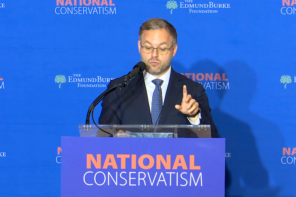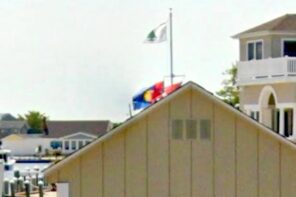With Mitt Romney tightening his grip on the GOP nomination, media coverage of Mormonism is splitting along familiar faultlines.
Last week, the BBC aired an exposé by investigative reporter John Sweeney that dug into sensitive community issues like the shunning of former Mormons and esoteric elements of LDS temple ceremonies. Sweeney even managed to put high-ranking LDS Church leaders on the defensive on camera.
Last weekend, at the worldwide LDS Semi-Annual General Conference, it was Church leaders’ turn to broadcast their own messages about Mormonism, preaching the importance of Christian service, forgiveness, and obedience, and offering spiritual encouragement to families caring for children with disabilities.
Which image is correct? The sharp split between two reflects a persistent divide in representations of Mormons. Nineteenth-century stereotypes depicting Mormons as secretive, deluded, and possibly dangerous persist, while contemporary Mormon efforts have promoted friendly, hardworking, family-oriented, well-scrubbed counter-images.
The real story, of course, lies somewhere in between. This weekend, I looked for it among the thousands of Mormons who flocked to Temple Square in downtown Salt Lake City for the Saturday afternoon General Conference sessions.
On Saturday afternoon at Temple Square, warm winds scattered petals from blooming pear trees as Mormons of every age, shape, and color move between the granite temples and monuments and freshly-planted beds of yellow tulips and purple hyacinths and pansies.
A group of dark-haired, twenty-something women in spiky high heels and pencil skirts laughed and mugged for a friend’s camera in front of the enormous granite LDS Conference Center, kissing a small Brazilian flag.
Young Tongan men stand squarely in groups, palming thick books of LDS scripture, wearing tupenu—traditional calf-length linen wraparound skirts–with their white shirts and ties.
Gauntlets of young locals in dark suits line walkways on the north side of Temple Square, cheerfully singing hymns from the screens of their iPhones or from green-backed hymnals, while a clutch of protestors—evangelical Christians, mostly, the same familiar, ragged gang materializing every conference—takes its place behind barricades on a small patch of grass.
A stranger, upon learning that I don’t have one of the highly-coveted tickets to the Sunday Conference sessions, spontaneously offers me his last extra.
Mitt Romney would blend right in amongst the crowds here. But so would Marco Rubio. Or Antonio Villaraigosa. Or any clean-cut man in a white shirt and tie, any woman in Sunday dress with a baby stroller.
I try to strike up a conversation with an African woman dressed in a pagne.
“Where are you from?” I ask her.
“Congo,” she says, then looks at me pityingly. “Je ne sais que parler francais,” she says.
I do not speak French. But the Brazilian Mormon standing on the other side of her does, and the two continue the conversation without me.
I leave elm-lined walkways of Temple Square and cross the street to the sparkling new LDS Church-owned City Creek Mall, a 23-acre, 700,000-square foot shopping center, opened in March. The Temple Square-end of the City Creek Mall features luxury high-rise condominiums and upscale shops like Tiffany’sand Nordstrom’s.
Many LDS people view the City Creek Mall as an emblem of savvy financial stewardship, a sure-to-be-profitable $1.5 billion investment designed to revitalize Salt Lake City’s downtown—yet another wholly owned commercial subsidiary of a prosperous multinational institution.
Others express real reservations about the mall, voicing concern that a religious institution might have elected to revitalize its capital city by building affordable housing, or developing sustainable local industries that pay a family wage.
One gay Mormon friend told me, “I read The Book of Mormon, and it does not say that gay sex brings the downfall of a civilization. The consumption of fine linens and costly apparel—pride—does.”
But most of the Mormons shopping City Creek this Saturday General Conference afternoon put such thoughts out of their minds. There is, instead, a sense of assurance—in seeing so many other LDS people of all ethnicities and nationalities in one place, surrounded by sparkling glass-storefronts and bubbling fountains.
The Mormonism I see in downtown Salt Lake City on General Conference weekend is that of a twenty-first century church completing an aggressive transition from regionally-specific American theocracy to a global institution. It’s a transition that has costs, very human ones, as Mormons concerned with the status of LGBT members, or women, or with growing rates of disaffiliation among young people will tell you.
Recent surveys of Church members have linked rising rates of youth disaffiliation to increased internet access and information about thorny historical issues—like the polygamy of Joseph Smith, or the historical facticity of LDS scripture. Google is ending the informational isolation of contemporary Mormons the way the railroad and automobile once ended the faith’s geographical and cultural isolation in the American west. At the same time, some analysts suggest, congregational growth is also slowing—dramatically.
But the prevailing sense of early 21st century LDS institutional life is that the best way to deal with such anxieties is to push through them, and that the best expression of the faith is the projection of a sense of assurance as polished and attractive as the storefronts at City Creek Mall.
That’s how most Mormons plan to walk through what may very well be a season of public relations nightmares, as Romney’s GOP candidacy brings even greater scrutiny to sensitive issues like historical racism, gay Mormon suicides, and unwelcome posthumous baptisms.
And it’s that very human, very modern, very religious tension between anxiety and assurance that the best media coverage of Mormonism in the upcoming season will offer.




